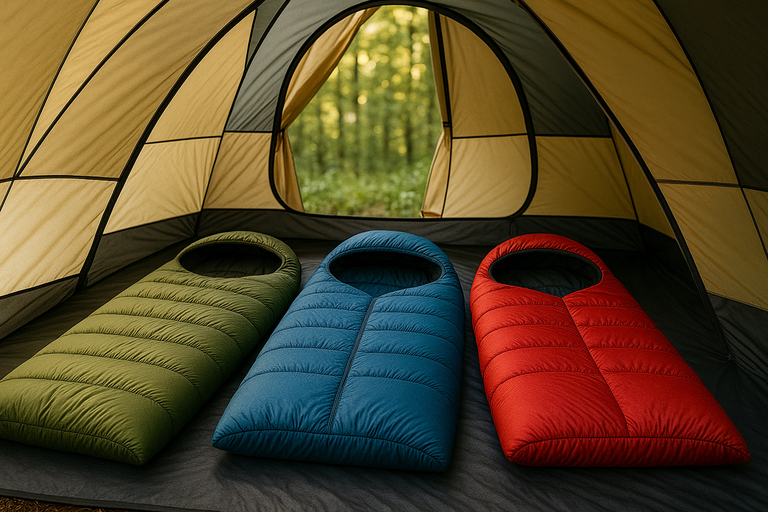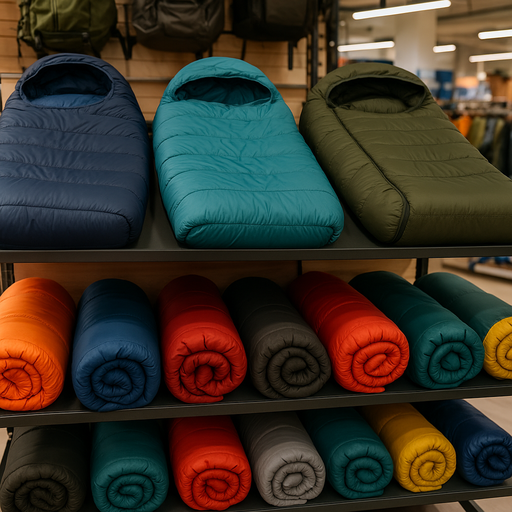When it comes to preparing for the unexpected, a well-stocked bug out bag is your lifeline, and choosing the right sleeping bag is a crucial piece of that puzzle. Imagine being caught in the wilderness, the temperature plunging as the sun sets. The right sleeping bag can be the difference between a restful night and an uncomfortable struggle against the cold. Our essential guide will walk you through everything you need to consider—insulation types, weight, packability, and temperature ratings—ensuring you select the perfect sleeping bag to keep you warm and ready for any situation. Whether you’re an avid adventurer or just looking to enhance your emergency preparedness, this guide will help you make informed choices that align with your needs. Stay warm, stay prepared, and equip yourself with the knowledge to brave the elements with confidence!
Essential Guide to Choosing the Perfect Sleeping Bag for Your Bug Out Bag: Stay Warm and Prepared!<br/>
Understanding the Importance of a Sleeping Bag in a Bug Out Bag
When preparing for an emergency, the items in your bug out bag can make all the difference. One critical component often overlooked is the sleeping bag. A sleeping bag isn’t just about comfort—it’s a key survival tool that can protect you from hypothermia and ensure you get the rest you need to stay alert and functional. When the temperature drops, a good sleeping bag can mean the difference between life and death.
Imagine finding yourself in the wilderness after an unexpected evacuation. Night falls, and the temperature begins to plummet. Without a proper sleeping bag, you could face a long, sleepless night, which can significantly affect your physical and mental state. Conversely, a well-chosen sleeping bag offers a safe cocoon, providing insulation from the cold ground and retaining your body heat. This ensures you stay warm and can get the rest needed to tackle the challenges of the next day.
Moreover, a sleeping bag is an essential part of the broader survival strategy. It pairs with other gear like tents, tarps, and ground pads to create a comprehensive shelter system. Understanding its role and selecting the right one tailored to your specific needs and environment will enhance your overall preparedness and boost your chances of staying safe and comfortable in any situation.

Key Features to Look for in a Sleeping Bag
When choosing a sleeping bag for your bug out bag, several key features should guide your decision. Firstly, the type of insulation is crucial. Sleeping bags generally come with either down or synthetic insulation, each with its advantages and disadvantages, which we’ll explore later. The choice of insulation affects the bag’s warmth, weight, compressibility, and performance in various conditions.
Another important feature is the temperature rating. This rating indicates the lowest temperature at which the sleeping bag will keep an average sleeper warm. It’s essential to select a sleeping bag with a temperature rating appropriate for your typical environment. If you plan for multiple seasons, consider a three-season sleeping bag that offers versatility across a range of temperatures.
Additional considerations include the sleeping bag’s shape and size. Mummy bags, for instance, offer a snug fit and excellent heat retention but might feel restrictive to some. Rectangular bags offer more room to move but are generally bulkier. The bag’s weight and packability are also vital, especially if you need to travel light. Features like zippers, hoods, and compression sacks can further enhance the bag’s functionality. All these factors combined will help you make an informed decision tailored to your needs.
Types of Sleeping Bags: Which One is Right for You?
Sleeping bags come in various types, each designed to meet specific needs and preferences. The most common types include mummy bags, rectangular bags, and semi-rectangular bags. Mummy bags are popular for their excellent heat retention and lightweight design. They are tapered at the feet and have a hood, which helps minimize heat loss. However, they can feel restrictive due to their snug fit.
Rectangular sleeping bags, on the other hand, offer more space for movement, making them a good choice for those who prioritize comfort over weight and packability. They are also easier to zip together to form a double sleeping bag for two people. However, their bulkiness and poorer heat retention make them less ideal for extreme conditions.
Semi-rectangular bags strike a balance between the two, providing better heat retention than rectangular bags while offering more room than mummy bags. They are a versatile choice for those who need a middle ground. Ultimately, the right type of sleeping bag for you will depend on your specific needs, preferences, and the conditions you’ll be facing. Understanding these differences will help you choose a sleeping bag that best suits your survival strategy.
Temperature Ratings Explained: How to Choose the Right Bag for Your Climate
Temperature ratings can be confusing, but they are crucial for selecting the right sleeping bag. These ratings indicate the lowest temperature at which the bag will keep an average sleeper warm. However, it’s important to note that these ratings are based on standardized testing and may not account for individual differences in metabolism, clothing, or shelter conditions.
Most sleeping bags are rated using the EN (European Norm) or ISO (International Organization for Standardization) standards, which provide a range of temperatures: comfort, limit, and extreme. The comfort rating indicates the lowest temperature at which a cold sleeper will remain comfortable. The limit rating is the lowest temperature at which a warm sleeper will remain comfortable. The extreme rating indicates the temperature at which the bag will keep a sleeper alive, but not necessarily comfortable.
To choose the right sleeping bag for your climate, consider the lowest temperatures you are likely to encounter. It’s generally a good idea to select a bag with a temperature rating slightly lower than the expected conditions to ensure you stay warm even if the weather is colder than anticipated. Additionally, consider using a sleeping bag liner for extra warmth and versatility. By understanding temperature ratings and choosing accordingly, you can ensure your sleeping bag will keep you warm and safe in any situation.

Material Matters: Down vs. Synthetic Sleeping Bags
When it comes to insulation, the two main options are down and synthetic. Each has its advantages and disadvantages, making them suitable for different situations. Down insulation, made from the plumage of ducks or geese, is highly prized for its exceptional warmth-to-weight ratio. Down sleeping bags are lightweight, compressible, and offer excellent insulation, making them ideal for cold weather conditions.
However, down has some drawbacks. It loses its insulating properties when wet and can be difficult to dry out in the field. Additionally, down bags tend to be more expensive than their synthetic counterparts. If you choose a down sleeping bag, look for one with a water-resistant treatment to help mitigate these issues.
Synthetic insulation, on the other hand, is made from man-made fibers designed to mimic the properties of natural down. Synthetic sleeping bags are generally more affordable and perform better in wet conditions, as they retain their insulating properties even when damp. They also dry faster than down bags. However, synthetic bags tend to be bulkier and heavier, offering less warmth for their weight. The choice between down and synthetic insulation will depend on your specific needs, preferences, and the conditions you’ll be facing.
Size and Weight Considerations for Your Bug Out Bag
When assembling your bug out bag, size and weight are critical considerations. A sleeping bag that is too bulky or heavy can be a burden, making it difficult to move quickly and efficiently. Therefore, it’s essential to find a sleeping bag that offers a good balance between warmth, weight, and packability.
Mummy bags are often a popular choice for bug out bags due to their lightweight design and excellent compressibility. They can be packed down to a small size, making them easy to carry without taking up too much space. However, if you prefer a rectangular or semi-rectangular bag, look for one made from lightweight materials and with a compact design.
Consider the overall weight of your bug out bag and aim to keep it as light as possible. A good rule of thumb is to limit the total weight of your gear to no more than 20-25% of your body weight. This will ensure you can move quickly and comfortably without being weighed down. By carefully considering the size and weight of your sleeping bag, you can ensure it fits seamlessly into your bug out bag and enhances your overall preparedness.
Additional Features: Zippers, Hoods, and Compression Sacks
Beyond the basic features, several additional elements can enhance the functionality of your sleeping bag. Zippers, for instance, can make a significant difference in comfort and convenience. Look for sleeping bags with high-quality zippers that run smoothly and are less likely to snag. Some bags feature two-way zippers, allowing you to vent the bag from the bottom for better temperature control.
Hoods are another crucial feature, especially for mummy bags. A well-designed hood can help retain heat and provide extra insulation for your head, which is essential in cold conditions. Look for hoods with drawstrings or adjustable closures that allow you to snugly secure the hood around your head.
Compression sacks are invaluable for reducing the packed size of your sleeping bag. These sacks use straps to compress the sleeping bag into a smaller, more manageable size, making it easier to fit into your bug out bag. Some sleeping bags come with their own compression sacks, while others may require you to purchase one separately. By considering these additional features, you can enhance the functionality and convenience of your sleeping bag.

Maintenance and Care Tips for Your Sleeping Bag
Proper maintenance and care are essential to ensure your sleeping bag remains in good condition and retains its insulating properties. After each use, air out your sleeping bag to remove any moisture and odors. If possible, hang it up to dry completely before packing it away. This will help prevent mold and mildew, which can damage the insulation and reduce the bag’s effectiveness.
When cleaning your sleeping bag, always follow the manufacturer’s instructions. Most sleeping bags can be machine washed on a gentle cycle using a mild detergent. However, down sleeping bags require special care and should be washed with a down-specific detergent. Avoid using fabric softeners, as they can damage the insulation. After washing, tumble dry your sleeping bag on a low heat setting with a few clean tennis balls to help restore loft.
Store your sleeping bag in a large, breathable storage sack or hang it up when not in use. Avoid keeping it compressed in a stuff sack for extended periods, as this can damage the insulation. Regularly inspect your sleeping bag for signs of wear and tear, and repair any small holes or tears promptly. By following these maintenance and care tips, you can extend the lifespan of your sleeping bag and ensure it remains an effective part of your bug out bag.
Recommended Sleeping Bags for Bug Out Bags
Choosing the right sleeping bag for your bug out bag can be overwhelming, given the multitude of options available. To help narrow down your choices, we’ve compiled a list of recommended sleeping bags that offer a good balance of warmth, weight, and packability. These options are well-suited for various conditions and needs, ensuring you stay prepared for any situation.
One highly recommended option is the Therm-a-Rest Questar 20. This down sleeping bag offers excellent warmth-to-weight ratio, making it ideal for colder conditions. It features a water-resistant down treatment to enhance performance in damp environments and includes a comfortable hood and draft collar for added warmth.
For those who prefer synthetic insulation, the Marmot Trestles 30 is a reliable choice. This sleeping bag provides good warmth and durability at a more affordable price point. It performs well in wet conditions and includes a spacious footbox and a hood with a drawcord for better temperature control. Additionally, the Trestles 30 comes with a compression sack for easy packing.
Another versatile option is the REI Co-op Magma Trail Quilt 30. This quilt-style sleeping bag offers the flexibility to be used as either a quilt or a traditional sleeping bag, making it a great choice for those who need versatility. It features high-quality down insulation, a water-resistant shell, and an ultralight design, making it perfect for lightweight backpacking and emergency preparedness.
Conclusion: Making an Informed Choice for Your Survival Gear
Selecting the perfect sleeping bag for your bug out bag is a crucial step in ensuring your preparedness for any emergency situation. By understanding the importance of a sleeping bag and considering key features such as insulation types, temperature ratings, size, weight, and additional elements like zippers and hoods, you can make an informed decision that aligns with your specific needs.
Remember, the right sleeping bag can make all the difference in keeping you warm, comfortable, and ready to face the challenges of the wilderness. Whether you choose down or synthetic insulation, a mummy or rectangular shape, or a sleeping bag with specific additional features, the goal is to find a sleeping bag that fits seamlessly into your bug out bag and meets the demands of your environment.
By following this essential guide and considering the recommended sleeping bags, you can equip yourself with the knowledge and tools to stay warm, prepared, and confident in any situation. Your bug out bag is your lifeline, and a well-chosen sleeping bag is a vital component of that lifeline. Stay warm, stay prepared, and face the elements with confidence!

